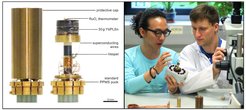Press Release: Large magnetocaloric effect and adiabatic demagnetization refrigeration with YbPt2Sn
Dongjin Jang, Thomas Gruner, Alexander Steppke, Keisuke Mitsumoto, Christoph Geibel & Manuel Brando
The unexpected and complex developments of history have often unfavorably influenced scientific work. In such times, it is up to scientists to find creative solutions which allow further research. Scientists in Dresden have discovered a new material with which temperatures close to absolute zero can be achieved.
In material science, studies often require low temperatures, sometimes near absolute zero (-273.15 °C). Quantum fluids like the two isotopes of the noble gas helium, 4He and 3He, are needed to reach such low temperatures. Especially for temperatures below 2 K (-271.15 °C), the extremely rare 3He is essential. Pure 3He is currently in limited supply on a market that can no longer satisfy the demand for its many various uses, and costs are extremely high. Low-temperature physicists required only 1.3% of the available 3He between 2004 and 2010.
The adiabatic demagnetization refrigerator (ADR) is a smart alternative. This device does not require 3He, but makes use of the entropy change in magnetocaloric materials (MCM), which are essentially paramagnetic compounds. While gas-handling for refrigerators containing 3He can be rather complicated, ADRs provide far easier use: To cool down the system, a heat-switch is operated while controlling the magnetic field. This technique is also used at room temperature, as an alternative to standard domestic refrigerators or in space projects where zero-gravity cryostats are required.
The most popular MCMs at low temperatures are paramagnetic salts which were first introduced 80 years ago. But the use of salts has significant disadvantages. They are unstable when exposed to humidity; in order to ensure constant cooling for a sufficiently long time-period, it is necessary to use sealed containers. Thermal insulation is also very high in salts at low temperature. They can only absorb enough heat if they are implanted in complex metallic structures, which occupy space and therefore reduce the total entropy density within the container.
Up to now, metals were thought to be poor MCMs because of their tendency to leave the paramagnetic state during magnetic or superconducting phase transitions. We have recently discovered that a remarkable exception from this behaviour is YbPt2Sn. Although it is a good conductor, it has the extraordinary quality to remain paramagnetic down to 0.25 K. Its volumetric entropy capacity is three times larger than that of common paramagnetic salts. An ADR we built ourselves was in fact powerful enough to cool 30g of metallic brass structure down to 0.2 K, starting from 2 K, with only 10g of YbPt2Sn. This material can easily be cast into rods (see video clip in Nature Communications online) that can, for instance, be used in ordinary commercial PPMS cryostats (see Figure). Our discovery provides a new, practicable alternative to 3He-based refrigerators and could trigger the search for new and better metallic MCMs.
DJ, TG, AS, MB / CPfS

Set-up for the PPMS. The set-up is made up of a PPMS puck, a vespel tube, a brass plate which holds a single ingot pillar (30 g) of YbPt2Sn.
The protective cap can be screwed on the puck.
